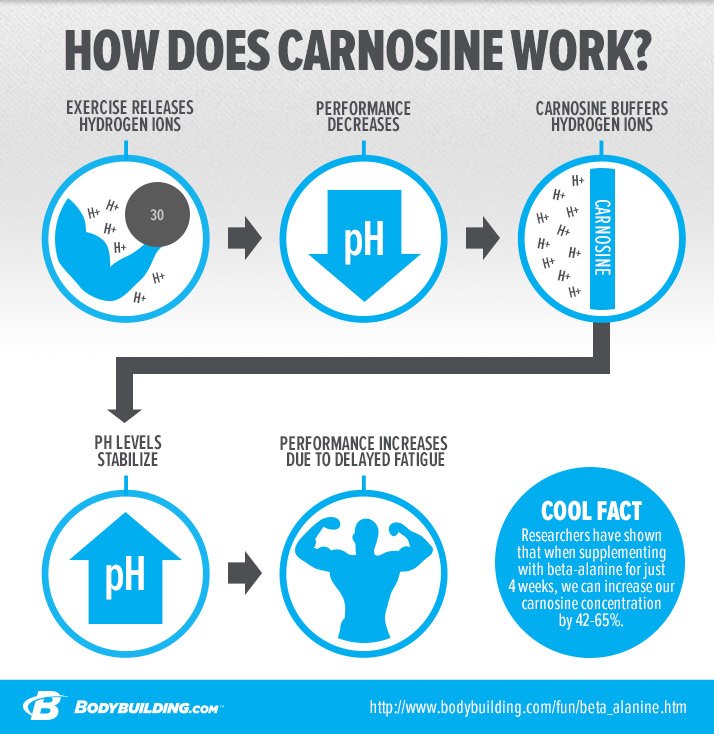
Beta-Alanine: Science Meets Real World Results!
Beta-alanine efficacy is backed by major university and peer-reviewed studies. In reading this article, you will understand how beta-alanine works. You will also learn how to maximize its use and how it can help you safely.
With literally hundreds of different supplements available and so many that are based on bogus claims and ridiculous hype, it's a challenge to find even one that delivers results. If you've rummaged through the garbage of the supplement scrap heap, you know how difficult it is to find solid science or real-world proof.
Beta-alanine is an exception. This supplement actually lives up to its claim: beta-alanine efficacy is backed by major university, peer-reviewed studies performed on humans, not the typical cell or rat studies upon which many supplement manufacturers generally base claims.
The science behind beta-alanine makes sense and it works. In reading this article, you will understand how beta-alanine works. You will also learn how to maximize its use and how it can help you safely work out much harder and longer. Used properly, beta-alanine can take your training and results to new levels, helping you set personal records and add lean mass. First lets start with some basic background information on beta-alanine.
Background On Beta-Alanine
Although only recently brought to the forefront, beta-alanine was discovered over 100 years ago. Also known as 3-aminopropanoic acid, it is a non-essential amino acid and is the only naturally occurring beta-amino acid. Not to be confused with alanine, beta- alanine is classified as a non-proteinogenic amino acid as it is not used in the building of proteins.

The greatest natural dietary sources of beta-alanine are believed to be obtained through ingesting the beta-alanine containing dipeptides: carnosine, anserine and balenine, rather than directly ingesting beta-alanine. These dipeptides are commonly found in protein rich foods such as chicken, beef, pork and fish.
However, obtaining beta-alanine through these dipeptides is not the only way, as our bodies can synthesize it in the liver from the catabolism of pyrimidine nucleotides which are broken down into uracil and thymine and then metabolized into beta-alanine and B-aminoisobutyrate. Of course, it can also be ingested through direct supplementation which is the focus of this article.
Recently, researchers began studying beta-alanine and examining its effects on exercise performance and lean body mass. We owe a great deal of credit and respect to the scientists who are in the trenches doing the work and publishing the research on beta-alanine.
If it wasn't for them, great supplements like beta-alanine and creatine might never have seen the light of day. Their ongoing research has revealed how to properly use these compounds and how to safely and effectively maximize their benefits.
One of the key scientists pioneering the performance research on beta-alanine is Dr. Roger Harris. His name may or may not sound familiar, but it should, as he is the same man that brought creatine to the bodybuilding world with his groundbreaking study in 1992.
It looks like the good doctor has found another juggernaut of a supplement in beta-alanine. However, he is not alone. In the last two years, highly respected research scientist Dr. Jeffrey Stout has been in a frenzy publishing and compiling research on beta-alanine and doesn't look to be slowing down any time soon. Other notable researchers who have been publishing research on beta-alanine include Dr. Tallon, Dr. Hill and Dr. Kim.
How Can Beta-Alanine Benefit Me?
Below is a list of the benefits of beta-alanine. But before we go on to explain how beta-alanine works, you must first understand what's going on in our body's during exercise that limits our gains and muscular performance.
Benefits of Beta-Alanine as supported by Scientific Studies
- Boosts explosive muscular strength and power output.
- Increases muscle mass.
- Boosts muscular anaerobic endurance.
- Increases aerobic endurance.
- Increases exercise capacity so you can train harder and longer.
What Stops Us From Reaching Our Full Potential In Making Strength, Endurance And Muscle Mass Gains?
When we exercise, especially when it's high intensity exercise, our bodies accumulate a large amount of hydrogen ions (H+), causing our muscles' pH to drop (become more acidic). This process is occurring whether you feel a burn or not.
The breakdown of ATP and the subsequent rise in H+ concentrations occur in all of our energy systems but H+ buildup is most prevalent in an energy system called glycolysis, which also produces lactic acid. At physiological pH, lactic acid dissociates H+ and is the primary source of released H+ ions during exercise, causing pH to drop.

It is the released H+ from lactic acid that causes muscular performance problems, not the leftover lactate ions as many incorrectly believe. While lactic acid is the primary source of released H+, it is not the only source. H+ ions are also being released at a rapid rate when you break down the high energy compound ATP during exercise. With the presence of many sources during energy production releasing H+, pH drops quickly.
As our muscles pH quickly drops, so does their ability to contract forcibly and maintain a high level of performance throughout your workout session. Not being able to perform and maintain forceful muscular contractions and push your body to the limit during your workout session, seriously hampers your ability to maximally overload your muscles and force new muscle gains.
In a nutshell, H+ causes your muscles pH to drop, in turn decreasing your strength and causing you to fatigue faster. These limitations stop you from adequately overloading your muscles and forcing NEW muscle gains.
So How Can Beta-Alanine Help Us Overcome This Drop In pH That Limits Strength, Endurance And Muscle Mass?
To understand how beta-alanine works to fight the drop in pH within our muscle, you must first understand how carnosine works. The reason being is, beta-alanine's performance benefits are not direct but realized through its ability to boost the synthesis of carnosine.
Background On Carnosine
The Russian scientist Gulewitsch was the first to identify carnosine in 1900. Eleven years later, he would discover and identify its constituent amino acids, beta-alanine and histidine. Seven years later, Barger and Tutin and Baumann and Ingvaldsen confirmed Gulewitsch's findings. However, it wasn't until 1938 that the first research on carnosine and its effects on muscle buffering were published.
Carnosine is a naturally occurring di-peptide that is found in both type 1 and type 2 muscle fibers, but is in significantly higher concentrations in type 2 fibers. Type 2 muscle fibers are primarily used in high intensity strength workouts and are most responsive to muscular growth.
How Does Carnosine Work?
There are a handful of ways carnosine is thought to impact performance but its most studied function, and the focus of this article, is its role as an intracellular buffer. Carnosine helps stabilize muscular pH by soaking up hydrogen ions (H+) that are released at an accelerated rate during exercise.
Our bodies work to keep our pH in balance by utilizing various buffering systems. Buffers largely work by soaking up H+ to maintain optimal pH balance, which we need to function most effectively. As mentioned above, our muscles function best in a specific pH range. When pH drops below that range, so does muscular performance. By helping to keep us in a more optimal pH range, our muscles can continue to contract forcibly for a longer time.
There are a handful of buffering systems that work in our bodies. Some maintain pH in extra cellular fluids (ECF) outside of the cell, while others perform their duties in intracellular fluids (ICF) inside the cell and some perform in both.
Our focus in this article is on exercise performance and, as mentioned above, the primary source of H+ released during exercise is from lactic acid and ATP breakdown. Take a guess where this breakdown and release of H+ is occurring?

If you guessed inside our muscles or intracellular, you would be correct. As a result, the first line of defense in absorbing the H+ is going to be the cell from intracellular buffers such as carnosine, not from extra cellular buffers.
Aside from carnosine being just where we need it, buffering H+ inside our cells, it has additional, unique attributes that make it really shine. Carnosine is unique; in that, other natural buffering systems our bodies use are also used in many other cellular reactions aside from buffering, watering down much of their buffering abilities.
However, what makes carnosine really exciting, is that by supplementing with extra beta-alanine, we can specifically and dramatically increase carnosine levels. How much, you ask?
Researchers have shown that when supplementing with beta-alanine for just 4 weeks, we can increase our carnosine concentration by 42-65%. Longer beta-alanine studies going up to 10-12 weeks, show carnosine concentrations increased up to 80%. This is a tremendous increase in an already powerful intracellular buffer.
It is this large increase in buffering capacity within our muscles that is largely responsible for the strength, lean body mass, power and muscular endurance gains that researchers are seeing from beta-alanine studies.
Section Summary
By boosting carnosine concentrations, with beta-alanine, our type 2 muscle fibers can soak up more H+ and stay in an optimal pH range. By keeping our type 2 muscle fibers in an optimal pH range, they are better able to maintain maximal strength and endurance throughout your workout session and bring on new muscle gains.
Frequently Asked Questions On Beta-Alanine & Carnosine
QIs beta-alanine safe?
While this is not a frequently asked question, it should be. We understand many people care most about gaining muscle, looking great and performing at their best but safety should not be overlooked. We believe it should actually be the first question asked when considering a new supplement, even before you question efficacy.
The answer to the safety question is a resounding yes. Studies, going up to 12 weeks of continued beta-alanine use, have looked at a large array of blood biochemical, hematological and hormonal markers and no negative changes have occurred whatsoever. While it is impossible to say beta-alanine is one hundred percent safe until longer term studies are complete, we do know that up to 12 weeks of continued beta-alanine supplementation is indeed safe.
Why not just take carnosine instead of beta-alanine?
When you ingest carnosine intact, most of it is broken down in the gastrointestinal (GI) tract into its constituent amino acids, beta-alanine and histidine. Some intact carnosine does escape the GI tract freely but even that amount is quickly broken down in our blood by the enzyme carnosinase.
In a very short time, all the carnosine you just ingested is either eliminated or broken down into beta-alanine and histidine. These two amino acids are then taken into the muscle, where they are converted back into carnosine with the help of the enzyme carnosine synthetase.
Unfortunately, only about 40% of the carnosine you take actually contains beta-alanine, making it an inefficient source at best. You are better off, from both efficiency and a financial standpoint, taking beta-alanine directly.
You would have to take substantially more carnosine just to approach the increased concentrations of carnosine achieved by taking the scientifically recommended dose of beta-alanine. Clearly, taking beta-alanine is the superior solution to increasing carnosine levels.
How do we know beta-alanine is actually increasing carnosine levels?
Researchers have proven it by actually taking muscle biopsies (using a hollow needle to remove a small sample of muscle tissue) prior to the study and at various time points throughout the study. What they found is that beta-alanine does, in fact, effectively and significantly increase carnosine concentrations in the range of 42-80%, depending on the dosing and duration of the study.
Shouldn't I take extra histidine along with Beta-Alanine since histidine is a component of carnosine?
Probably no. Histidine is already present in high concentrations in muscle, while beta-alanine is only present only in small amounts. Researchers have determined that it is beta-alanine that drives carnosine synthesis, not histidine. Since this has been proven repeatedly in research, there is no need to supplement with extra histidine to increase carnosine levels.
There are potentially some select populations like vegans, vegetarians or the elderly that may not get enough histidine in their diets and are thus deficient, which may compromise optimal carnosine levels. But, we still don't recommend taking just extra histidine with beta-alanine.
Instead, we recommend these groups and simply bump up their total protein intake which will in turn solve their possible histidine deficiency. For the majority of healthy people, only beta-alanine is needed as histidine deficiency is rare and no extra supplementation is needed to increase carnosine concentrations.
At what point during my workout set will extra carnosine concentrations exert their strongest effects?
Boosting carnosine levels with beta-alanine is effective at all points during your set, whether you're lifting heavy or doing endurance work. Your body uses three energy systems to perform work: the ATP-PC system, which is primarily used during heavy lifting and for sets up into the 5-6 rep range; the glycolytic system, which is predominantly used roughly within the 7-15 rep range and up; and the oxidative/fat system, which is used primarily in endurance training.
Our energy systems are utilized simultaneously; however, depending on the level of intensity or duration of exercise and fitness levels of the individual, certain energy systems will become more dominant in producing energy needed for that activity. Anybody who trains with weights will primarily use the first two systems and, in both cases, the build-up of hydrogen ions will contribute to fatigue in both systems, especially glycolysis.

This is where the supplement creatine falls a little short. It is mostly effective in the ATP-PC system, which relies on stored ATP and re-synthesis using phosphocreatine (PC) for intense, high-energy contractions. Taking creatine will help your explosive strength but it won't help you much in the 7-15 rep range.
As anyone trying to build bigger muscles knows, you must train in both heavy and moderate (7-15 reps) ranges to maximize muscle mass gains. Beta-alanine, by increasing carnosine concentrations, can buffer/fight the H+ build-up that occurs in both these ranges, allowing you to maintain forceful contractions for longer periods of time.
Decreasing cellular fatigue is an additional strength of beta-alanine. A recent study demonstrates that beta-alanine outperformed creatine in decreasing cellular fatigue, giving it yet another advantage over what has been considered the most effective sport supplement of the last decade. With beta-alanine yielding impressive results in university performance studies, creatine's days at the top may be numbered.
Does beta-alanine replace creatine?
Beta-alanine does not replace creatine. As shown above, they work differently and creatine is still effective for maximizing strength and power. If anything, they should be taken together as the ultimate one-two punch.
How much beta-alanine is needed to cause performance increases?
Research has shown that you can take an amount between 3.2 grams and 6.4 grams per day to significantly boost carnosine levels and improve performance. The most recent research, now using 4-5 grams a day, is showing comparable carnosine concentration and performance improvements to those using 6.4 g daily.
Who can benefit from beta-alanine?
- Individuals participating in weight training looking to gain lean body mass and increase strength.
- Any individual involved in athletic activities where strength, power and muscular endurance are needed.
- Active individuals who have reached a training plateau and are looking for a supplement to take them to the next level.
How long will it take to start noticing benefits?
Performance benefits typically occur in as little as two weeks, although some individuals will notice benefits within one week. As carnosine levels increase, the benefits will follow. The most dramatic results are generally experienced within the 3-4 week range but they don't stop there.
Recent research is now showing carnosine levels continue to increase for a minimum of 12 weeks which is why we recommend staying on beta-alanine for at least three months to optimize your carnosine levels.
Immediate benefits: Many users experience intense vasodilation/pumps from the very first dose of beta-alanine. This experience occurs because beta-alanine increases carnosine and carnosine is a powerful precursor in generating nitric oxide synthase (a group of enzymes necessary for making the powerful vasodilator nitric oxide).
Are there any methods that may increase beta-alanine's ability to increase carnosine levels?
Yes. A recent study showed that a group of subjects taking Beta-Alanine with carbohydrates increased performance gains in half the time of the group taking an equal amount of beta-alanine without carbohydrates. Carbohydrates spike insulin and one of insulin's effects is to increase amino acid (such as beta-alanine) transport into our cells.
Taking beta-alanine pre-workout and post-workout may increase the uptake of beta-alanine into our muscles. Amino acid nutrient timing studies have clearly shown when amino acids are ingested pre-workout and post-workout, their delivery and uptake into our muscles is increased. The improved uptake is largely due to increased blood flow during exercise.
What is the prickling I feel when I first take Beta-Alanine?
The prickling - called parathesia - is caused by beta-alanine binding to nerve receptors, activating them and causing them to discharge/fire. Many of these nerves are below the skin, giving a prickling/pins-and-needles sensation. This sensation begins approximately 15-20 minutes after ingesting beta-alanine and usually continues for 1-1.5 hours.
The intensity varies depending on dosing, individual sensitivity and potentially from activators of Ca2+ channels, such as caffeine. This sensation, though generally enjoyed, often subsides over a few weeks of continued use. Carbohydrates/food may also blunt the prickling effect from beta-alanine.
If I don't feel the prickling does that mean beta alanine isn't working on me?
The prickling sensation does not occur at all in some individuals, even when taking 4-6 grams of beta-alanine at one time. Do not worry if you are in this group. The prickling is NOT a sign that beta-alanine is working or being absorbed by your muscles and converted to carnosine. If you are feeling nothing, you need not be concerned as it is still increasing your carnosine stores as research has repeatedly shown.
A good example of this phenomenon is when combining carbohydrates with beta-alanine. Not only do carbohydrates blunt much of the prickling sensations, they also increase beta-alanine's performance gains faster than beta-alanine without carbohydrates.

Another good example is comparing studies that measure carnosine concentrations using multiple small 800 mg doses of beta-alanine vs. studies using multiple doses of 1.6 g of beta-alanine. The total daily amount of beta-alanine ingested is similar and the duration of the studies using both dosage strategies is matched up as well.
800 mg is low enough to cause little to no prickling, based off feedback from both research and anecdotal, where as 1.6 g can cause quite a lot. The outcome of both studies showed carnosine concentrations were very similar.
Is taking taurine at the same time as beta-alanine going to stop beta-alanine from boosting carnosine and performance levels?
While there is certainly potential for problems when taking these two together (they share the same transporter into tissues), it hasn't yet been supported in the research to any level of significance. In fact, a recent study by Dr. Harris, showed that the increase in muscle carnosine with beta-alanine was not reduced when taurine was taken along with it.
We could get into the biochemistry of why taking taurine with beta-alanine may not seem like a good idea but we have a more simple and conclusive explanation just in case you wanted more proof to support Dr. Harris's study.
Since there is a group of studies that used either beta-alanine by itself or beta-alanine with taurine, we examined them to determine if there were any differences in the resulting carnosine concentrations. While more research is always needed, there are quite a few beta-alanine vs. beta-alanine plus taurine studies, and their outcomes are all the same.
There is little to no difference in carnosine concentrations. In other words, taurine does not appear to inhibit beta-alanine from being absorbed to any level of significance, otherwise carnosine levels would have been lower in the beta-alanine plus taurine studies.
Conclusion
We hope our article has given you a much better understanding of how beta-alanine works and why it is so effective. It truly is the next tier in sports nutrition and we may not see anything as effective for 10-15 years, just as it was with creatine.
Look for beta-alanine to grow in popularity as more people experience the power first hand and beta-alanine rises to the forefront in sport's performance university research.
References
- Hoffman J, Ratamess N, Kang J, Mangine G, Faigenbaum A, Stout J. (2006) Effect of Creatine and ß-Alanine Supplementation on Performance and Endocrine Responses in Strength/Power Athletes. IJSNEM, 16(4).
- Zoeller RF, Stout JR, O'kroy JA, Torok DJ, Mielke M.(2006) Effects of 28 days of beta-alanine and creatine monohydrate supplementation on aerobic power, ventilatory and lactate thresholds, and time to exhaustion. Amino Acids, 1-6
- Harris RC, Tallon MJ Dunnett M, Boobis L, Coakley J, Kim HJ, Fallowfield JL, Hill CA, Sale C, Wise JA (2006) The absorption of orally supplied §-alanine and its effect on muscle carnosine synthesis in human vastus lateralis. Amino Acids, March.
- Harris RC, Ponte J, Sale C, Jones GA, Kim HJ, Wise JA. Effect of 14 and 28 days B-Alanine(Carnosynâ„¢) supplementation on isometric endurance of the knee extensors. Univeristy of Chichester, Chichester UK; Korea National Sport Univeristy, Seoul Korea. Poster Presentation
- Harris RC, Marlin DJ, Dunnett M, Snow DH, Hultman E ((1990) Muscle buffering capacity & dipeptide content in the thoroughbred horse, greyhound dog & man. Comparative Biochem Physiol 97A: 249-251
- Harris, R C.; Hill, C; Wise, J A. (2003) Effect of combined Beta-Alanine and creatine monohydrate supplementation on exercise performance. Medicine & Science in Sports & Exercise: Volume 35(5) Supplement 1 May 2003 p S218
- Harris RC, Dunnett M, Greenhaff PL(1998) Carnosine & Taurine contents in individual fibers in human vastus lateralis muscles. J Sports Sci 16: 639-643.
- Hill CA, Harris RC, Kim HJ, Harris BD, Sale C, Boobis LH, Kim CK, Wise JA (2006) . Amino Acids.
- Hill C. A., R. C. Harris, H. J. Kim, L. Boobis, C. Sale, J. A. Wise. "The effect of beta-alanine and creatine monohydrate supplementation on muscle composition and exercise performance." (Presented at the American College of Sports Medicine Annual conference, 2005, Nashville.)
- Kim HJ, Kim CK, Lee YW, Harris RC, Sale C, Harris DB, and Wise JA (2006) The effect of a supplement containing ß-alanine on muscle carnosine synthesis and exercise capacity, during 12 wk combined endurance and weight training. J. Inter. Soc. Sports Nutr. 3(1): S9
- Stout JR, Cramer JT, Mielke M, O'Kroy J, Torok D, and Zoeller RF (2006) Effects of 28 days of beta-alanine and creatine monohydrate supplementation on the physical working capacity at neuromuscular fatigue threshold. J Strength Cond Res(in press)
- Stout JR, Cramer JT, Zoeller RF, Torok D, Costa P, Hoffman JR (2006) Effects of beta-alanine supplementation on the onset of neuromuscular fatigue and ventilatory threshold in women. Amino Acids. Nov 30
- Suzuki Y, Ito O, Takahashi H, Takamatsu K (2004) The effect of sprint training on skeletal muscle carnosine in humans. Intl J Sport Health Sci 2: 105-110.
- Suzuki Y, Ito O, Mukai N, Takahashi H, Takamatsu K (2002) High Level of Skeletal Muscle Carnosine Contributes to the Latter Half of Exercise Performance during 30-s Maximal Cycle Ergometer Sprinting. Jpn J Physiol 52:199-205.
- Bate-Smith EC (1938) The buffering of muscle in rigor: protein, phosphate and carnosine. J Physiol 92: 336- 343,1938.
- Gulewitsch W, Amiradzibi S. Uber das carnosine, eine neue organische Bases des Fleischextraktes, Ber Disch Ges 1900; 33:1902-4.
- Barger G, Tutin F. Carnosine, constitution and synthesis. Biochem J 1918; 12: 402-

